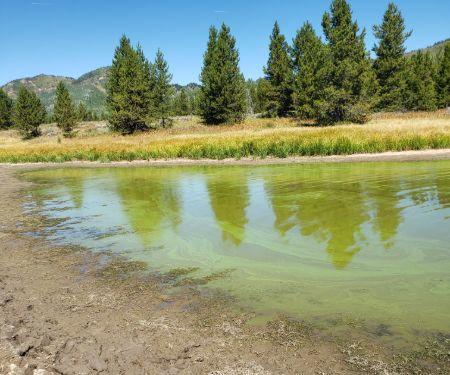Toxic algae
Toxic algae or harmful algae blooms are made up of what many people call blue-green algae. Technically, these organisms are a special type of bacteria called cyanobacteria or cyanoHABs. Although these organisms naturally occur in Colorado waters, they become a problem when they multiply rapidly, resulting in a dense cyanobacteria concentration or “bloom”. The blooms become harmful when the cyanobacteria produce toxins.
Some (but not all) water bodies in Colorado are monitored and tested for toxic algae to protect the health and safety of water users. Always look for caution or warning signs before allowing children, pets, or yourself to come into contact with water.
If you see algae blooms
- Stay out of the water.
- Don't drink the water.
- Keep your pets and livestock away from the water.
- Avoid boating near or through algae blooms.
- Clean fish well with clean water and properly discard guts.

Data
Recent blooms for select water bodies. Please contact the water body manager for the most current conditions.
- Colorado risk management toolkit for recreational waters
- Toxic algae caution, warning, and close signs for managers of Colorado waters
- Do not use these signs without following the flow chart in the management toolkit.
Questions and answers
What problems do toxic algae cause for drinking water systems?
Toxic algae are made up of cyanobacteria, commonly known as blue-green algae, and in drinking water sources, can cause the water to taste or smell bad. Taste and odor are not regulated but create customer concerns about water quality and safety. Most complaints water utilities receive are about taste and odor, and these issues can last for prolonged periods. In addition to taste and odor problems, toxic algae can create a public health risk when they produce toxins. Removing toxins in a safe and cost-effective way can be a challenge for treatment facilities, and not all are equipped to do so.
Are toxic algae in drinking water regulated?
No, and they are not routinely tested for either. After Toledo, Ohio, experienced a severe problem with toxic algae in 2014, the EPA developed health advisory guidance for water systems and suggested a multiple-step process to identify and address problems. Following this guidance is not a regulatory requirement. The department partnered with local universities, water organizations, industry, and water providers to develop monitoring guidance to assist Colorado drinking water providers.
How can I tell if an algae bloom is toxic?
The only way to be certain if an algae bloom is toxic is to run specific water tests. The Colorado Laboratory Services Division is one lab that can complete these tests.
Could toxic algae affect a public water supply?
Yes. This happened in Toledo, Ohio, in 2014. The economic consequences of such an event can be severe.
How can I get help?
Drinking water providers can contact the Water Quality Control Division at 303-692-3500 with questions about toxic algae. We can help water providers who experience taste and odor problems and toxins. This includes ideas about customer communication and steps utilities can take to monitor and manage toxic algae and best treat their drinking water.
Resources
Monitoring guidance: Drinking water providers using surface water.